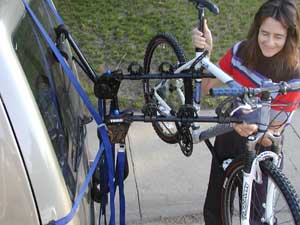|
Take Your Bikes Along Car racks: How to choose them, how to use them |
|
Why Do You Need a Rack? Because great bicycling is not always within easy riding distance. A car rack expands your horizons and makes it easy to take your bikes to a nearby rail-trail or trailhead or on vacation. And, with your two-wheeler(s) on a rack, you retain full use of your vehicle's interior storage space (and avoid grease stains on that rich Corinthian leather).
Three Types to Choose From
Your local bicycle store has a wide variety of car racks and the expertise to help you choose the right one for your vehicle and sporting needs. Here's what you'll see when you get to the store:
Roof Rack: For decades, bike enthusiasts have racked their bikes on top. The advantages to roof racks are numerous. The bike is protected from damage in case of a fender-bender (but watch those overhangs, especially your own garage!). The bike attaches by the wheels or the front fork, so there's no chance for scratches. Roof racks are the most versatile multi-sport haulers for skis, kayaks and other adult toys, too. Roof racks can also be fitted with a cargo box, which expands carrying capacity dramatically.
Roof racks can also be a little more difficult to load. If your car is tall, or you're not, you may need a stool to stand on to make loading easy. Since the rack does touch the car's paint, a roof rack is not as finish-friendly as a hitch rack. A roof rack to carry two bikes starts at about $350.
Hitch Rack: The SUV and the mini-van have made hitch-mounted racks a popular choice. They fit easily into the receiver hitch common on SUVs. There's no contact between the rack or bikes and your car, so there's no worrying about your car's finish. Many hitch racks fold or swing out of the way so you can access the rear hatch without removing the bikes. If your bikes are more dear to you than your car, you may prefer a roof rack (should you get rear-ended, the bikes are at risk on a hitch rack). Two-bike hitch racks start at about $150.
Trunk Rack: If you're looking for a compact, inexpensive way to carry bikes, the trunk rack does the job. It sits on your trunk lid or hangs on your rear hatch, with a system of rubber feet, pads, straps and hooks to secure it to the car. It's not the easiest on your car or bikes, but it does have the advantage of folding easily to fit into your trunk so it's always with you. A trunk rack to carry two bikes starts at about $75.
Rack Up and Go!
It's a three-step process:
1) Attach the rack to your car
2) Attach the bikes to the rack
3) Double-check everything after you've driven a ways
1) First, attach the rack to the car, carefully following the manufacturer's instructions. Many people leave their roof racks on all the time, because they may also use them for skis in winter. Hitch racks are easy to attach by inserting them into your receiver hitch. Strap-on racks are generally removed and reattached with every use.
Security is an issue, because racks aren't cheap and you need them to be there when you return from your ride. Most roof and hitch racks have extra-cost locking options. Strap-on racks can be removed and locked inside the vehicle.
2) Attaching the bikes to the rack takes a little practice. It's generally best to criss-cross the bikes, alternating between bikes facing left and right (for hitch or strap-on) or bikes facing front and rear (for roof racks). This way, the handlebars don't clash.
Roof racks, which hold bikes with the wheels in trays, are usually the most accommodating of bikes of different shapes and sizes, with one exception: Kid's bikes with 20" wheels or smaller usually don't fit on racks designed to have the front wheel removed.
Hitch or strap-on racks do fine for adult bikes, where the frames hang from the top tube, or crossbar. Women's frames, kid's bikes and the new full-suspension bikes with unusually shaped frames sometimes require creative racking or even a detachable crossbar to give the rack something to hold.
3) Once you get the bikes on the rack, check to make sure the wheels aren't near hot exhaust, and that any straps are tight and not hanging down where they could catch on moving car parts. Check the pedals to see that they won't scratch the paint on the other bikes. Of course all attachments to the car should be snug.
Set your watch alarm for 15 minutes before you drive away. When the alarm sounds, stop when it's convenient and check all the connections between rack and car and rack and bikes. The 15 minutes of driving allows everything to settle in and loosen up if it's going to. Also, check again at every gas stop. Better safe than sorry!

